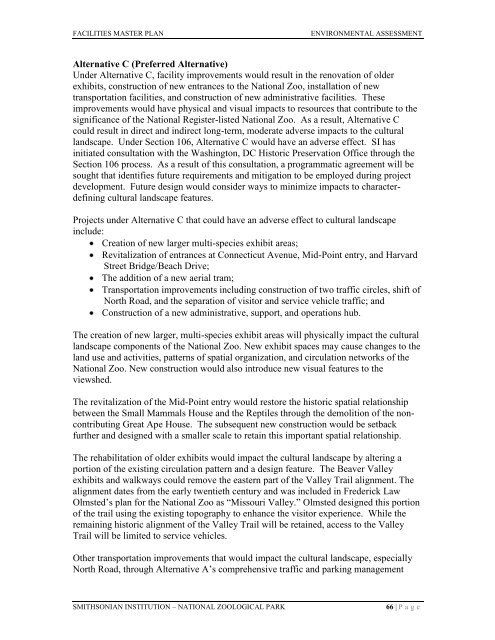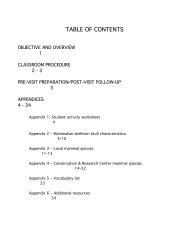facilities renewal master plan - National Zoo - Smithsonian Institution
facilities renewal master plan - National Zoo - Smithsonian Institution
facilities renewal master plan - National Zoo - Smithsonian Institution
You also want an ePaper? Increase the reach of your titles
YUMPU automatically turns print PDFs into web optimized ePapers that Google loves.
FACILITIES MASTER PLAN ENVIRONMENTAL ASSESSMENT<br />
Alternative C (Preferred Alternative)<br />
Under Alternative C, facility improvements would result in the renovation of older<br />
exhibits, construction of new entrances to the <strong>National</strong> <strong>Zoo</strong>, installation of new<br />
transportation <strong>facilities</strong>, and construction of new administrative <strong>facilities</strong>. These<br />
improvements would have physical and visual impacts to resources that contribute to the<br />
significance of the <strong>National</strong> Register-listed <strong>National</strong> <strong>Zoo</strong>. As a result, Alternative C<br />
could result in direct and indirect long-term, moderate adverse impacts to the cultural<br />
landscape. Under Section 106, Alternative C would have an adverse effect. SI has<br />
initiated consultation with the Washington, DC Historic Preservation Office through the<br />
Section 106 process. As a result of this consultation, a programmatic agreement will be<br />
sought that identifies future requirements and mitigation to be employed during project<br />
development. Future design would consider ways to minimize impacts to characterdefining<br />
cultural landscape features.<br />
Projects under Alternative C that could have an adverse effect to cultural landscape<br />
include:<br />
Creation of new larger multi-species exhibit areas;<br />
Revitalization of entrances at Connecticut Avenue, Mid-Point entry, and Harvard<br />
Street Bridge/Beach Drive;<br />
The addition of a new aerial tram;<br />
Transportation improvements including construction of two traffic circles, shift of<br />
North Road, and the separation of visitor and service vehicle traffic; and<br />
Construction of a new administrative, support, and operations hub.<br />
The creation of new larger, multi-species exhibit areas will physically impact the cultural<br />
landscape components of the <strong>National</strong> <strong>Zoo</strong>. New exhibit spaces may cause changes to the<br />
land use and activities, patterns of spatial organization, and circulation networks of the<br />
<strong>National</strong> <strong>Zoo</strong>. New construction would also introduce new visual features to the<br />
viewshed.<br />
The revitalization of the Mid-Point entry would restore the historic spatial relationship<br />
between the Small Mammals House and the Reptiles through the demolition of the noncontributing<br />
Great Ape House. The subsequent new construction would be setback<br />
further and designed with a smaller scale to retain this important spatial relationship.<br />
The rehabilitation of older exhibits would impact the cultural landscape by altering a<br />
portion of the existing circulation pattern and a design feature. The Beaver Valley<br />
exhibits and walkways could remove the eastern part of the Valley Trail alignment. The<br />
alignment dates from the early twentieth century and was included in Frederick Law<br />
Olmsted’s <strong>plan</strong> for the <strong>National</strong> <strong>Zoo</strong> as “Missouri Valley.” Olmsted designed this portion<br />
of the trail using the existing topography to enhance the visitor experience. While the<br />
remaining historic alignment of the Valley Trail will be retained, access to the Valley<br />
Trail will be limited to service vehicles.<br />
Other transportation improvements that would impact the cultural landscape, especially<br />
North Road, through Alternative A’s comprehensive traffic and parking management<br />
SMITHSONIAN INSTITUTION – NATIONAL ZOOLOGICAL PARK 66 | P a g e

















